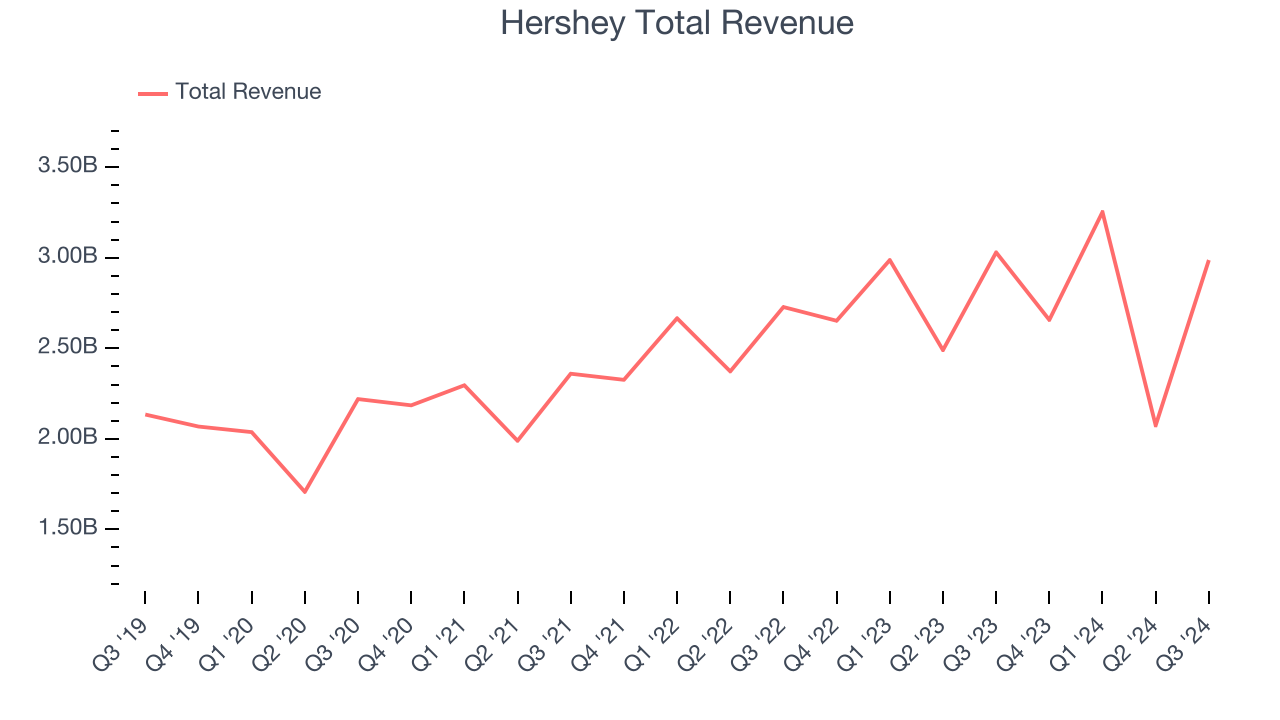
Chocolate company Hershey (NYSE: HSY) missed Wall Street’s revenue expectations in Q3 CY2024, with sales falling 1.4% year on year to $2.99 billion. Its non-GAAP profit of $2.34 per share was also 8.3% below analysts’ consensus estimates.
Is now the time to buy Hershey? Find out by accessing our full research report, it’s free.
Hershey (HSY) Q3 CY2024 Highlights:
- Revenue: $2.99 billion vs analyst estimates of $3.07 billion (2.8% miss)
- Adjusted EPS: $2.34 vs analyst expectations of $2.55 (8.3% miss)
- Management lowered its full-year Adjusted EPS guidance to $9.05 at the midpoint, a 5.1% decrease
- Gross Margin (GAAP): 41.3%, down from 44.9% in the same quarter last year
- Operating Margin: 20.5%, down from 24.3% in the same quarter last year
- Organic Revenue fell 1% year on year (10.7% in the same quarter last year)
- Sales Volumes fell 3% year on year (0.9% in the same quarter last year)
- Market Capitalization: $35.77 billion
"We believe in the resiliency of our snacking categories and the strength of our brands," said Michele Buck, The Hershey Company President and Chief Executive Officer.
Company Overview
Best known for its milk chocolate bar and Hershey's Kisses, Hershey (NYSE: HSY) is an iconic company known for its chocolate products.
Shelf-Stable Food
As America industrialized and moved away from an agricultural economy, people faced more demands on their time. Packaged foods emerged as a solution offering convenience to the evolving American family, whether it be canned goods or snacks. Today, Americans seek brands that are high in quality, reliable, and reasonably priced. Furthermore, there's a growing emphasis on health-conscious and sustainable food options. Packaged food stocks are considered resilient investments. People always need to eat, so these companies can enjoy consistent demand as long as they stay on top of changing consumer preferences. The industry spans from multinational corporations to smaller specialized firms and is subject to food safety and labeling regulations.
Sales Growth
Reviewing a company’s long-term performance can reveal insights into its business quality. Any business can have short-term success, but a top-tier one sustains growth for years.
Hershey is one of the larger consumer staples companies and benefits from a well-known brand that influences consumer purchasing decisions.
As you can see below, Hershey’s sales grew at a decent 7.5% compounded annual growth rate over the last three years despite consumers buying less of its products. We’ll explore what this means in the "Volume Growth" section.

This quarter, Hershey missed Wall Street’s estimates and reported a rather uninspiring 1.4% year-on-year revenue decline, generating $2.99 billion of revenue.
Looking ahead, sell-side analysts expect revenue to grow 5% over the next 12 months, a slight deceleration versus the last three years. Some tapering is natural given the magnitude of its revenue base, and we still think its growth trajectory is satisfactory.
Unless you’ve been living under a rock, it should be obvious by now that generative AI is going to have a huge impact on how large corporations do business. While Nvidia and AMD are trading close to all-time highs, we prefer a lesser-known (but still profitable) semiconductor stock benefitting from the rise of AI. Click here to access our free report on our favorite semiconductor growth story.
Volume Growth
Revenue growth can be broken down into changes in price and volume (the number of units sold). While both are important, volume is the lifeblood of a successful staples business as there’s a ceiling to what consumers will pay for everyday goods; they can always trade down to non-branded products if the branded versions are too expensive.
To analyze whether Hershey generated its growth from changes in price or volume, we can compare its volume growth to its organic revenue growth, which excludes non-fundamental impacts on company financials like mergers and currency fluctuations.
Over the last two years, Hershey’s average quarterly sales volumes have shrunk by 2.6%. This decrease isn’t ideal as the quantity demanded for consumer staples products is typically stable. Luckily, Hershey was able to offset fewer customers purchasing its products by charging higher prices, enabling it to generate 2.7% average organic revenue growth. We hope the company can grow its volumes soon, however, as consistent price increases (on top of inflation) aren’t sustainable over the long term unless the business is really really special.

In Hershey’s Q3 2024, sales volumes dropped 3% year on year. This result was a reversal from the 0.9% year-on-year increase it posted 12 months ago. A one quarter hiccup shouldn’t deter you from investing in a business. We’ll be monitoring the company to see how things progress.
Key Takeaways from Hershey’s Q3 Results
We struggled to find many strong positives in these results as its organic revenue and EPS missed Wall Street’s estimates. Hershey also lowered its full-year EPS guidance. Overall, this was a weaker quarter. The stock traded down 2.6% to $172.13 immediately following the results.
Hershey underperformed this quarter, but does that create an opportunity to invest right now? When making that decision, it’s important to consider its valuation, business qualities, as well as what has happened in the latest quarter. We cover that in our actionable full research report which you can read here, it’s free.






